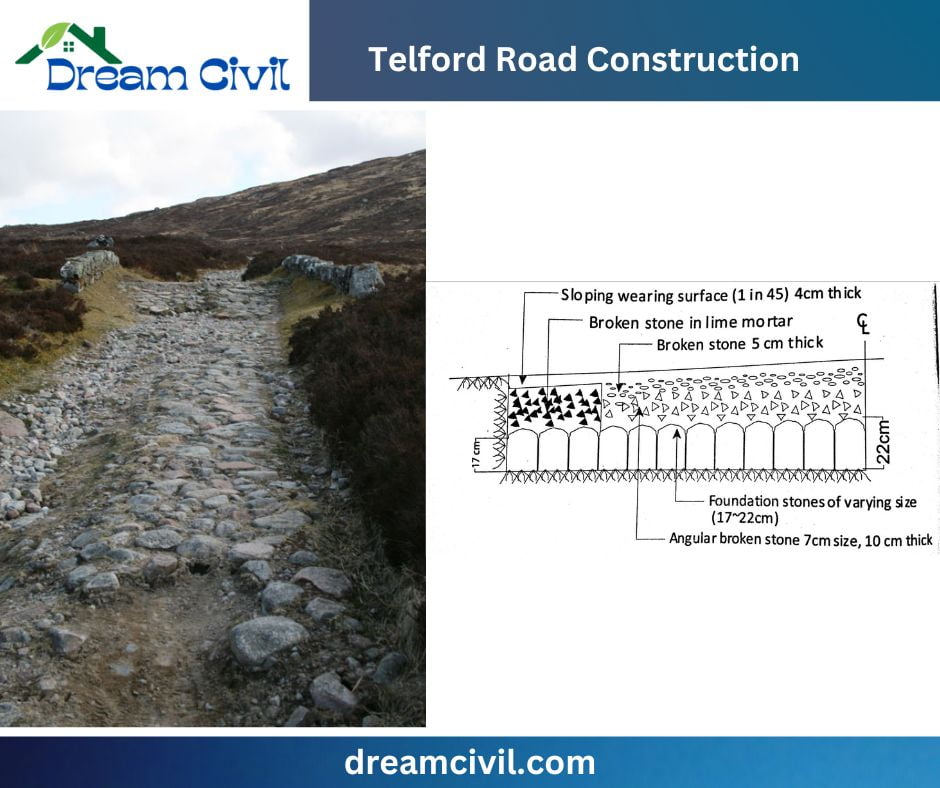Table of Contents
✔ Telford Road Construction was proposed and implemented by Scottish Civil Engineer Thomas Telford (1757 – 1834 AD), the founder & first president of the Institution of Civil Engineers (ICE) in London, who began road construction in the early 19th century.
✔ He believed in using a heavy foundation above the soil subgrade to keep the road foundation formed. He also insisted on providing a definite cross slope for the pavement’s top surface by varying the foundation stones’ thickness.
✔ He proposed providing cross drains at an interval of almost 90m, usually laid below the foundation level.
1. What were the features of Telford Road Construction?
Some of the features of Telford Road Construction are:
a. Stones of varying sizes (17 – 22 cm ) were utilized to make the road foundation.
b. Above this layer, angular broken stones of 7 cm size and 10 cm thickness were used in the central area, and broken stones along with lime mortar were used at the sides.
c. Generally, a wearing surface with a slope of 1 in 45 and thickness of 4 cm was constructed using pebels.
d. Cross drains were provided at an interval of almost 90m, usually laid below the foundation level.
2. How were Telford Roads constructed?
✔ To construct Telford Road, the initial step was to prepare the subgrade, which was the layer of soil where the road was built.
✔ Then, the foundation layer was built with large stones ranging from 17 to 22 centimeters in size, which were meticulously hand-packed for a secure fit.
✔ Following this, the intermediate layer, consisting of angular broken stones of 7 cm in size and 10 cm in thickness, was used in the central area, and broken stones along with lime mortar were used at the sides.
✔ The wearing surface composed of broken stones, which was the top layer of the road, was then applied, with a slope of 1 in 45 and a thickness of 4 cm.
3. Was Telford Involved in the Design of Bridges Also?
Besides roads, he was also involved in the design of the following bridges & aqueducts stated below:
| Year | Name / Location |
|---|---|
| 1792 | Montford Bridge |
| 1796 | Buildwas Bridge |
| 1796 | Longdon-on-Tern Aqueduct |
| 1797 | Coundarbour Bridge |
| 1798 | Bewdley Bridge |
| 1801 | Chirk Aqueduct |
| 1805 | Pontcysyllte Aqueduct |
| 1806 | Glen Loy Aqueduct, Caledonian Canal |
| 1808 | Tongland Bridge |
| 1809 | Dunkeld Bridge |
| 1810 | Bridgnorth Bridge |
| 1811 | Helmsdale Bridge |
| 1812 | Bonar Bridge |
| 1813 | Telford Bridge, Invermoriston |
| 1815 | Craigellachie Bridge |
| 1815 | Dunans Bridge |
| 1815 | Waterloo Bridge, Betws-y-Coed |
| 1818 | Sligachan Old Bridge |
| 1819 | Bannockburn Bridge |
| 1820 | Cantlop Bridge |
| 1823 | Stanley Embankment |
| 1824 | Eaton Hall Bridge |
| 1826 | Conwy Suspension Bridge |
| 1826 | Menai Suspension Bridge |
| 1826 | Mythe Bridge |
| 1827 | Holt Fleet Bridge |
| 1827 | Over Bridge |
| 1827 | Bridge of Keig |
| 1829 | Galton Bridge |
| 1831 | Dean Bridge, Edinburgh |
| 1831 | Lothian Bridge, Pathhead |
| 1832 | Broomielaw Bridge, Glasgow |
| Read Also: Ancient Roman Roads |
| Verified Article By Er. Madhu Krishna Poudel |


